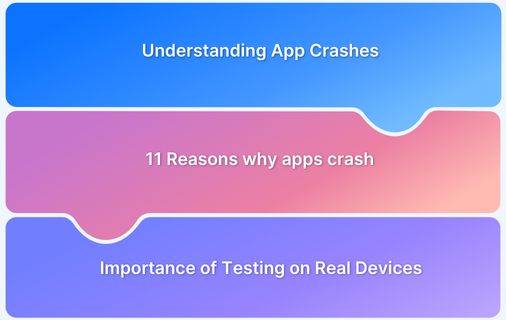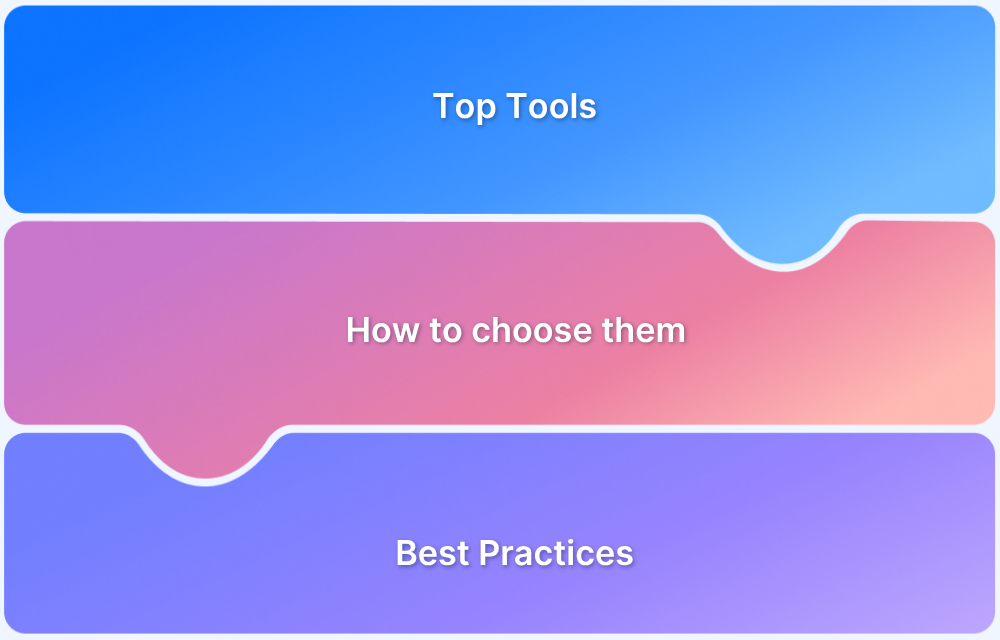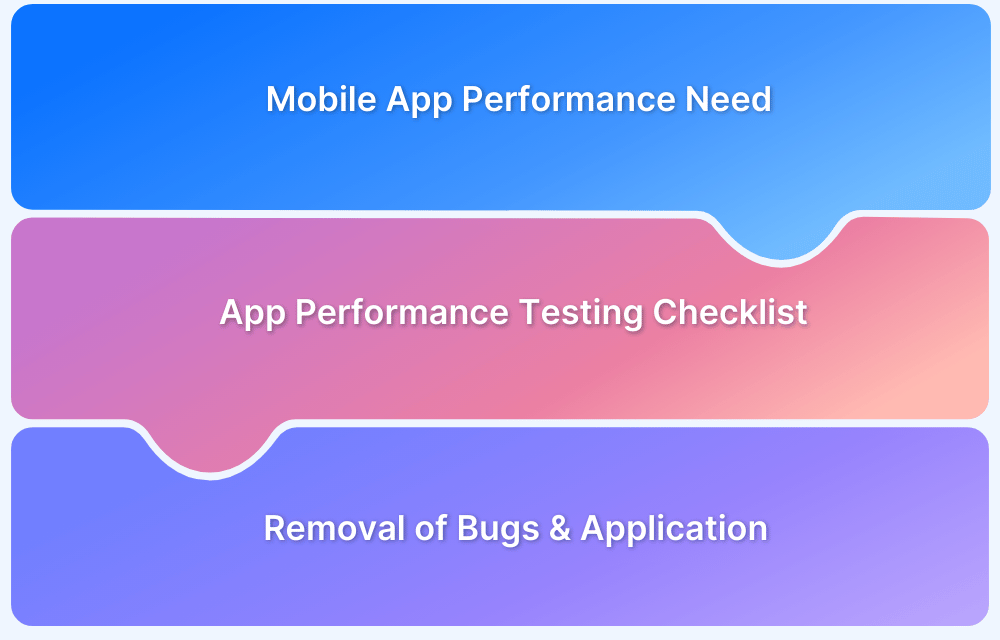17 Relevant Mobile App Testing Statistics
By Shreya Bose, Community Contributor - November 15, 2024
Mobile app testers ensure the quality and performance of mobile apps, which are the touchpoints of people’s digital lives. App users demand perfection and rely entirely on first impressions to form opinions about an app. Therefore, comprehensive mobile app testing is not up for negotiation.
This article will list key statistics that will shed some light on user behavior so that testers can create effective user personas. Furthermore, these mobile app statistics will also help get a deeper sense of why apps need to be tested thoroughly in real user conditions to stand a chance of offering satisfactory user experiences.
Why is Mobile App Testing Important?
Here’s why mobile app testing is important for your business:
- Flawless user experience: Users look for responsive and seamless experiences. Mobile app testing ensures your app is user-friendly, loads fast, and is responsive.
- Device Compatibility: Your app should work across various devices, browsers, and OSs. Testing practices like real-device testing ensure a consistent user experience across different OS versions and devices.
- Functionality Verification: Mobile app testing ensures that all your functions work perfectly under different scenarios and real user conditions.
- Security and Privacy: Mobile apps have to manage sensitive data. So, it is very important to test for vulnerabilities like data leaks, unauthorized access, and encryption flaws.
- Cost Efficiency: Detecting bugs early in the development phase can help you save time and money.
- Brand Reputation: A bad user experience can really affect your brand reputation and increase the churn rate. Testing helps you overcome that.
Read More: What is Mobile App Testing?
17 Important Mobile App Testing Statistics
Here are 17 important mobile app testing statistics that every app tester should know:
1. Crashes cause 71% of app uninstallations
Apps cannot afford to be unstable and unreliable. Once again, the only way to ensure app stability is to test in on real mobile devices and platforms (iOS, Android, Windows, etc.). It needs to be tested in various real-world situations such as low battery, incoming calls, sudden changes in network strength, etc.
Ensuring flawless app performance is challenging enough on single devices. Now, consider the extent of device-platform fragmentation in the market. Let’s look at a basic list of Android OS versions as an example:
| Android OS version | Cumulative Distribution |
| 4.0 “Ice Cream Sandwich” | 0.2% |
| 4.1 – 4.2 – 4.3 “Jelly Bean” | 1.7% |
| 4.4 “KitKat” | 4% |
| 5 “Lollipop” | 9.2% |
| 6 “Marshmallow” | 11.2% |
| 7 “Nougat” | 12.9% |
| 8 “Oreo” | 21.3% |
| 9 “Pie” | 31.3% |
An app has to work perfectly on every single one of these Android versions, as well as each device these versions operate on. Given that this is a basic list, apps have to be optimized perfectly for hundreds of device-OS combinations across the world. If cross device and platform compatibility are not ensured, then it will see increased uninstallation on certain devices or platforms.
Comprehensive app testing on real mobile devices ensures that the app adheres to the same high standards of operation on all possible devices and operating systems. That means that the app does not miss out on certain demographics, and stands a better chance of success.
Try testing on Real Devices and Platforms for Free
2. 70% of users abandon an app because it takes too long to load
All devices, platforms, and network connections are not born equal. An app can load lightning fast on some devices and lag intolerably on others. However, don’t expect users to be understanding of this phenomenon. Given the nature of device-OS fragmentation in existence, it is inevitable that any app will be accessed via a wide variety of smartphones, tablets and the like. If an app is in existence, it must be optimized for as many devices as humanly possible – legacy and latest versions alike.
3. More than half of downloaded apps are unused
204 billion apps were downloaded in 2019. The average individual has 40 apps installed on their smartphones. However, 89% of the user’s time is spent using only about 18 apps.
As it stands, people don’t use the majority of the apps they download. An app has to be on-point in terms of functions and aesthetics to even stand a chance of being in regular use, to start with. Ensuring this is only possible via thorough app testing on real mobile devices.
4. 29% of users will immediately abandon an app if it does not offer value to them
The point about testing must be repeated here. But it must be added that apps must be marketed accurately towards a relevant target audience. Other than being displeased with its performance, a key reason for app uninstallation is the user discovering that the app doesn’t do what they want.
In this case, preventing uninstallations has to start with market research that actually reveals what users want, implementing those offerings, and making the app visible to the right audience.
There is no way to perform said app optimization without real mobile device testing.
5. 65% of users think less of a brand due to poor mobile experience
In most cases, the app represents the company online. Apps offering sub-par user experiences leave negative impressions of the brand itself. If this happens, users will be less likely to use the app as well as other products by the same brand.
6. The average mobile user checks their smartphone 47 times a day
If an app has to be good enough to be used with such frequency, it cannot afford to be flawed. Ensure that no matter how often a user accesses the app, it matches their expectations every single time. Once again, exhaustive app testing is the only way to guarantee such consistency.
7. 50% of customers tend to uninstall an app that occupies too much device space
Large apps can slow down user devices and restrain space for other files. Therefore, it is important to optimize app size.
8. Slow app releases can cost companies over $100k every year
Three out of four companies depend on mobile apps for a quarter of their revenue, and 75% of companies report that slow app releases cost them over $100k every year.
9. Global app downloads have shot 2x every quarter since 2015
The popularity and demand for mobile applications are increasing every quarter. Therefore, the need for thorough testing of mobile apps is greater than ever.
Read More: How to test Mobile Applications?
10. 86% of people spend more time on apps than on websites
With mobile apps being so popular, strong testing strategies should be in place to meet user expectations and boost experience.
11. 94% users uninstall mobile applications within 30 days of installation
This data stresses the significance of focusing on delivering high-quality and intuitive mobile applications to the users.
12. Only 25% of app users return after the first day of usage
This happens when your app does not deliver a seamless user experience along with a reliable set of functional features. This eventually reduces the retention rates.
13. Teams that integrate testing in development save 22% of their time
Integrating test and QA practices throughout the development process helps identify, analyze, and fix bugs earlier. Thus helping you reduce the costs associated with it at a later stage.
14. 80% of users use Google Chrome and Mozilla Firefox
Though Chrome and Firefox are most popular, many users still use browsers like Yahoo. So, the best practice would be to ensure your app works across all major browsers through cross-browser testing.
15. Mobile shoppers clicking recommendations are 25% more likely to complete orders
It goes without saying that testing recommendations and other personalized features are essential to driving great user experiences and conversions.
16. The global market for mobile app testing services is expected to reach $13,585.73 million by 2026
This surge in market growth is a testament to the importance of mobile app testing as the demand for high-quality apps increases.
17. Jobs for quality assurance professionals are projected to grow by 25% by 2031
As the mobile app market expands, the demand for QA professionals, software developers and testers will keep increasing.
Read More: Top 10 Skills of a Proficient QA Manager
Why Choose BrowserStack for Mobile App Testing
Here’s why you should choose BrowserStack for Mobile App testing:
- Automated and Manual testing: BrowserStack’s App Automate and App Live lets you run automated and manual testing on a real device cloud.
- Cross-browser and Real-Device Testing: Offers access to real Android devices and Android browsers to test your app behavior in real-user conditions.
- Network Simulation and Geolocation Testing: Simulates different locations and network conditions ( 2G, 3G, 4G) to test show your Android app performs in multiple conditions.
- Seamless Integrations: Offers integrations with popular automation frameworks and CI/CD tools like Appium, Espresso, Jenkins, Travis CI and more.
- Parallel Testing: Lets you run hundreds of tests concurrently and speed up test execution.
Conclusion
By considering the discussed stats in app-related development decisions, devs and testers can be clear on what standards to meet and how to create tests to ensure top-notch performance.
Remember, users can lose faith at the slightest inconvenience, and they have multiple other options to choose from.
Therefore, developers and testers cannot afford to rely on emulators and simulators alone. They simply do not provide all the real-world conditions that an app has to excel in. For example, they will not allow testers to simulate a low battery or a weak network connection.
Apps need to be tested on real mobile devices. However, unless a testing team has an extensive in-house device lab (that is constantly updated with the latest devices), they will have to run their tests on a real device cloud.
BrowserStack’s cloud infrastructure provides real devices for iOS testing and Android testing. Testers can simply sign up, choose the required device-platform combination, and start running tests. Testers can run both manual and automated app tests and can speed up results with parallel testing.




